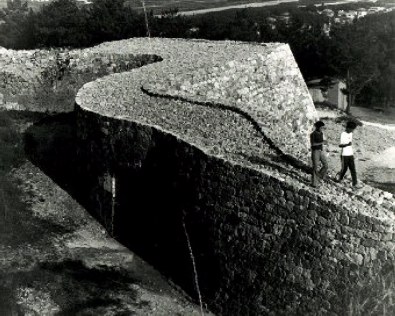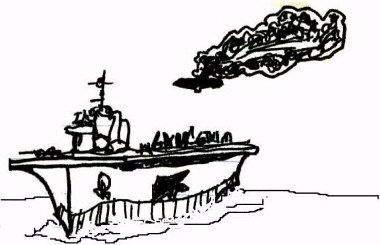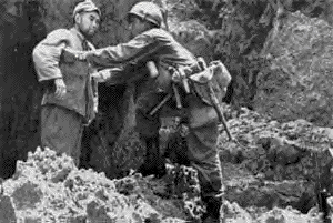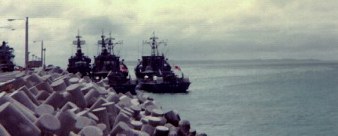Battle For Okinawa
It is more important now; than ever that the 'True History' of World War II be told to readers and researchers alike. This is especially so in the case of the war against Japan. The Japanese Government has continued to work to supress the facts of World War II or to distort or ignore the Japanese culpability in their actions across the width and breadth of Southeast Asia. This web site has been up and running since 1999; with variations and additions; long before the Movie: Pearl Harbor. That movie pointed out the problems with how the Japanese still see WWII; the facts of the story had to be rewritten to make it acceptable to the Japanese. Instead of a historical Docu-Drama it had to be played off as a romance. America might have won the war in the Pacific; but unless all Americans are willing to continue to honor the Brave Men and Women of WWII in the Pacific; their sacrifices will be ignored in the history works of the future; once history is forgotten it is destined to be repeated. - Bob Price/Webmaster
|
The Pivotal-Decision Battle of the Pacific War
By Bob Price
There were many Battles during World War II which changed the course of history. Some of these Battles were definative. Battles such as; Normandy's D+Day; The Battle of the Bulge, The Battles for the Coral Sea and Midway just to name a few.
 Suicide Cliffs: The Japanese Last Stand on Okinawa:
Bob Price at Suicide Cliffs 1975
Extremely desperate fighting on the Southern tip of Okinawa ended theofficial Japanese resistance on the island. Here many Okinawan women threw their children over the Cliffside and jumped after them to keep from being captured by the American Forces who were squeezing the conflict to a close. The
Japanese had convinced the local population that if their babies were takencaptives the Americans would 'eat' them. Another tragedy of the War.
|
These battles changed the situation; and turned the corner towards American superiority in their respective theatres of operations.
The Battle of Okinawa Changed the future.
Okinawa determined American military thinking for any upcoming battles against a defensive Japanese homeland; becoming the pivotal battle of decision for America's top military planners and thinkers in bringing an end to the war in the Pacific.
Okinawa
Okinawa is the largest of the Ryukyu Islands located in the East China Sea southeast of Kyushu, Japan's southernmost island; only 375 miles from mainland Kyushu. 'The Rock' as Okinawa is called; was foreseen as the staging area for the American invasion of Japan. If Okinawa could be captured then Iwo Jima, and the other captured Islands, would give the Americans a series of islands from which to stage later operations and would bring America one more step closer to the final battle to end all battles.
Control of these islands would cut Japan off from supplies and provide Americans with refueling and repair stations. These 'Stepping-Stones' as they were known; would allow American forces to "hop" from island to island.
This 'island hopping policy' would shorten the extended supply lines of the Americans; and cut off vital staging areas for Japan's offensive forces. The Ryukyu Island chain was to be the final island hop of the pre-invasion campaign. There the US knew they had the airstrips to handle B-29 bombers needed to hit the Japanese homeland hard. But the Japanese were well dug in. And the final chapter was yet to be written.
Positions of Elevation/Command and Control:
Prime Real Estate...
 Hill Top to Hill top Fighting
This is one of the Shuri-Castle areas of Okinawa
Where some of the heaviest fighting took place;
The hill is actually a pulverized remnant of an ancient
Castle blown apart by continued US bombardment.
|
'Prarie Dog Warfare'
Appointed chief-of-staff. Colonel Hiromichi Yahara, served as the chief planning officer for the Battle of Okinawa advocating a war of attrition, which called for a carefully planned defensive strategy rather than an all-out attack. The strategy on Okinawa was in marked contrast to previous battles, there would be no glorious dying by "crushing of the enemy at the water's edge," as was the formal policy of Japanese strategy during the war up to that point.
The Japanese had proven brave but futile in their defense of these crucial islands by wasting precious men, resources, and time. This traditional Japanese strategy had failed repeatedly. America was able to field forces in a 3 to 1 ratio to any island defenders and muscle enough technology to defeat any Japanese standing army. Yahara's tactical change was long overdue; and was tantamount to preparing an elaborate ambush for the Americans who would invade Okinawa.
Ushijima spent months turning Okinawa into a fortress by digging elaborate networks of tunnels that connected strategically located artillery positions. He stored enough water and essential supplies to last an extended period of time at each position.
The Japanese planned to lure the invading Americans inland by allowing an unopposed landing; then overpower them with the 32nd Imperial Army; thru counter-attacks and attrition by giving ground then reoccupying it.
Yomitan Castle Bolo Point
 Yomitan Castle Commanding the Heights
Centuries Old Yomitan Castle overlooks its kingdom
The wall you see has been completely reconstructed
Note: Wall to the far left; bombed out area yet to be repaired
Photo was taken from a Japanese Gun Position
that looked out to sea; the gun-mount was a metal ring
about 3' to 4' in diameter and mounted in cement;
the Gun was missing just north of Red Beach
|
Bombing Okinawa
The aerial bombardment of Okinawa commenced in 1944 and continued for 30 days and nights prior to the battle and was reinforced by tens of thousands of naval shells showering the Hagushi Beaches six days prior to landing.As American began to soften the beach-head. The Japanese, watched from hidden fortifications behind the Naha-Shuri Castle-Yonabaru Line to the south of the Hagushi Beaches. The main Japanese forces in-land survived the bombardment; thankful no-doubt that the Japanese leadership had chosen a more sensible theory of operations.
The Americans assembled the largest invasion force in history; larger and more powerful than Europe's D+Day.
April Fools Day - April 1, 1945; more than 60,000 American troops landed on the Hagushi beachhead. Opposition and casualties were light.
 The Kamikaze Plane was one of the most deadly Japanese tools. Here is a graphic of the USS Enterprise taking a direct hit on deck. But; on Okinawa the US Pacific Fleet put their ships in a Defensive Ring around Okinawa and were attacked with more than 600 Japanese Kamikaze Planes; 350 the 1st day.
Japan sensing the end near at hand; put into the air
every air-worthy craft they could find and pilots who had
no actual flying time. Every kind of plane the Japanese had was used in the attacks. The Japanese knew that Okinawa was their last hope; If Oki fell to the Allies; bombers could reach mainland Japan and return; and the Allied forces could begin a buildup of supplies to invade the Imperial Empire. I was always getting reports of Japanese planes
found by divers off the coast of Okinawa...somewhere out there lay the remains of all the Japanese airships and their crews; and some of the US ships they sunk.
|
Kamikaze bombings and strafing from the air were the sole signs of Japanese movement. The American's found dug-in positions lightly defended if defended at all. It was plain to see the Japanese had gone to ground. The question was...'Where?'
Soldiers fondly called L-Day; "Love Day;" it soon stretched into "Honeymoon week."
Compared to the beach-heads of Tarawa and Iwo Jima; Okinawa was a short-lived cake walk. American news-reels made quick propaganda work of the unopposed invasion; and concern in America for the war in the Pacific lost much of its steam. After visions of the mass slaughter during the D+Day invasion the Okinawan Campaigned paled in the public mind at the outset.
The landing on Okinawa contrasted with that on Iwo Jima so much that Admiral Turner was convinced the Japanese had given up. American planners were convinced that the remaining Japanese had 'taken to the hills' and had retreated into the Northern and Mountainous regions of Okinawa.
After securing the beachhead and two airfields in the first hours of the battle with minimal casualties (28 killed and 104 wounded), all from aerial attacks. Supplies and harbor activity increased and tons of resupply goods filled the beachheads. Commanders were enthusiastic about the situation.
Yomitan Airstrip the First Priority
 Japanese Aircraft were caught off guard
and at least one plane tried to land as the 6th Marines
took over the landing site. This is how the 6th Marines foundthe remainder of the strip when they got there.
|
In the south, a diversionary force of Marines feigned a landing on Minatoga Beaches completely fooling the Japanese - General Ushijima mistakenly rejoiced and reported to the Imperial Headquarters that his men had successfully repulsed the enemy with numerous casualties.
Within a few days, an American division moved north, soon reaching minor Japanese fortifications on the Motobu Peninsula. It was clear that the Japanese had not conformed to the expected.
By April 20, Northern Okinawa was conquered; except for Japanese holdouts who would continue to evade capture in remote areas (until the 1950's). Since this area posed no tactical threat to the American forces ashore it was simply cut off and abandoned.
Meanwhile, another division moved south toward Ushijima's Naha-Shuri Castle-Yonabaru Line of defense to join the American Twenty-fourth Corps, which had been halted at Kakazu Ridge, the strongest point in the line. There things began to take a turn for the worse.
Rainy April weather reduced visibility and Intelligence the American's derived from Aerial mapping was faulty. From the erroneous information; the Americans under-estimated the Japanese troops at only 65,000; in reality, more than 100,000 troops lay hidden in the maze of tunnels and caves. The trap was sprung.
The Americans attacked points all along the Japanese defense line that stretched from coast to coast. General Simon Buckner called the Japanese defense; 'Prarie Dog Warfare'.
"It's going to be really tough....
I see no way to get them out except by blasting them out yard by yard,"
- Major General John R. Hodge.
The weather quickly turned against the Americans. Okinawa's rain torrents and mud baths were miserable for the American troops and though the island is a tropical island; the humidity gives a cold wet and wintery feel to the seasonal monsoons causing problems in health and comfort.
The Americans slowly pierced the Shuri line, and Ushijima retreated, inch by inch. The Japanese Army was well-fortified but was whittled away by a determined American force; that paid dearly for each inch of land; most of the Imperial Army engaged in countless suicide charges.
On the last day, Lieutenant Generals Ushijima and Cho committed ceremonial hara-kiri (suicide), after ordering Yahara to escape to Tokyo. One American division assaulted a single position eleven times, losing twice the number of men originally in their company (including reinforcements). Japanese casualties grew steadily. Civilian casualties were un-countable up to that time; On June 21, 1945, all organized Japanese resistance ceased.
Okinawa; said Chester Nimitz;'...was the worst fighting of the Pacific war, its sustained intensity surpassing even the brutal combats of Tarawa, Peleliu, and Iwo Jima...Uncommon valor was a common virtue."
 GI checks surrendering Japanese soldier on Okinawa (US Army Photo)
|
With Okinawa's invasion force larger and stronger than Europe's D+Day; and the fighting more fierce than even that encountered on Iwo Jima and the other desperately Japanese defended islands the ferocity of the combat must have been overwhelming.
The Japanese defended Okinawa with a fanatic desperation even after realizing the unrelenting Americans were capable and determined to seize the victory. Both sides were well aware that Okinawa would be the pivotal battle; as Okinawa's occupation was vital to the outcome of the whole war. Each side gave everything they had in desperate combat.
The Japanese saw Okinawa as a trap and saw the Americans falling into the trap blindly. The Japanese General Staff looked on the battle as; "...the anvil on which the hammer-blows of an invincible Japan would destroy the American fleet..."
America saw Okinawa as 'the stepping stone' to mainland Japan. The confident Americans knew that the capture of Okinawa would bring the defeat of Japan. The Americans broke through the Japanese defenses and conquered Okinawa, but they witnessed unexpected and excessive bloodshed.
It was no secret the Japanese knew the Americans needed Okinawa as the foothold for their invasion forces. And the Japanese committed everything they could to destroying the 10th Army on Okinawa.
Japan mobilized the immense 32nd Imperial Army hoping to prevent the invasion, re-designed and committed her airforce as suicide Kamikaze Forces, introducing the new baka bomb (piloted suicide bomb), and worked to perfect the most successful network of defensive tactics used by the Japanese during the entire war. Failure to stop the Americans at Okinawa meant an imminent enemy land invasion of the Japanese homeland. The fighting on both sides was critical. Air attacks by Japanese planes on American ships off Okinawa killed 2,658 men during ten kamikazi attacks in which eleven ships were sunk and 102 damaged. The Navy alone lost a total of 5000 dead. The war though coming to an end ushered in a new definition of terror and fanatism unseen in modern warfare.
The Japanese saw the Okinawan's as an inferior race; and did not utilize them as their equal. In-fact Okinawa had never been a part of Japan proper but had remained basically autonomous with Castles; and Kingdoms of its own.
Okinawan citizens were put into Japanese slave labor units and were posted alongside the Japanese defenders. The war was in-discriminate and these civilians were killed along with the Japanese. Okinawan women were educated to believe that the American's would 'eat their children' if the children were captured and so mothers threw their children off of suicidal cliffs and then jumped over after them. Civilians were caught between the cross fires of each side; and were often mistaken as the enemy or were killed while hiding in caves where Japanese soldiers were or could have been lurking.
The American high command was appalled at the events but; the fighting was so desperate; so close-in and so unmanagable at times that all the Americans could do was to move forward and hope for victory. But; this civilian casualty rate alarmed the Americans as to what would undoubtably happen in the Homeland of Japan during an invasion. Okinawa was the eye-opener.
According to American Headquarters; The Battle of Okinawa was;
'...the bloodiest land battle of the Pacific war...'
American ground and naval forces reported 70,000 casualties. American planners were stunned at the losses in land forces and by the casualty rates following the Kamikazi attacks. 1 in 9 Kamikaze planes struck their target by pentrating the largest naval gun screen assembled.
These reports from Okinawa came as America contemplated the invasion of Japan; and the US readied it's Atomic weapons to be used as a tactical weapon against Japanese ground forces.
The Atomic bomb was never seen or contemplated as a war ending weapon until that point in history. The A-bombs were seen as a way of wiping out a mass of enemy forces without the extreme loss of life and casaulties experienced on the other defended islands of the South Pacific. Okinawa was the first place the US encountered the Japanese civilians in any great numbers and the loss of so many lives on both sides changed the idea that warfare against Japan could be fought on a level of casualty management.
After Okinawa the Amcericans came to the conclusion that no tactical use of the Atomic bomb would secure and guarantee victory over Japan by knocking out large masses of Japanese soldiers; as each inch and each foot and each yard of Japan would have to be taken by Buckner's 'Prarie Dog Warfare' tactics. Tactics that proved deadly and costly to civilians and the military alike.
It became clear. An invasion of Japan would account for millions and millions in dead, dying and wounded on both sides. Victory was not in-doubt; but the cost was.
"...I do not want another Okinawa from one end of Japan to the other..." said President Harry S. Truman
With Okinawa only a fraction of the size of mainland Japan Americans Optomistically went to work on Operation Downfall; The land invasion of Japan.
America sought low casualty figures in order to convince higher headquarters to carry out the invasion. MacArthur pushed for a land invasion. But, it was well-known the Japanese Army would continue to savagely resist an invasion despite the depletion of resources after defeat at Okinawa. Indeed the Japanese were harboring resources to commit to the invasion unknown to the American forces at the time; all land defenses were raised and the civilian population was mobilized and indoctrinated into the fanatic 'Banzi' death for the Emporer Corps.
Meanwhile; the first assessments of the invasion set the casualty rates for American and Japanese Civilians too low and underestimated the Japanese defense forces piting one branch of the service against another and setting up rivalries within the Intelligence services themselves.
Date Line Okinawa
History Texts
Skip Over Okinawa Battle
Local teachers’s associations are up in the arms after they were given a first look at new history text books scheduled for use from school year starting in 2002. The teachers are especially incensed that the books have only a few lines devoted to the Battle of Okinawa.
For example, atrocities committed by the Imperial Army against local civilians are not mentioned at all. The book mentions that many people here committed suicide during the battle, but does not say or mention that they were urged to kill themselves by the Imperial Japanese military authorities.
Teachers’ Association officials say that they are determined to oppose the new books by going to courts if necessary. “We have a duty to teach our children accurate history and what happened and why. It is unpardonable to wash over this part of our history,” a spokesman for the association was quoted saying in an interview.
Source:www.Japanupdate.com
For All things Okinawan Try out this site, Weather, Maps, News and More!
|
Operation Downfall; as it was conceived would have been a disaster for American forces. The Intelligence Agencies prepared three seperate assessments; each more grim than the other as more information was extracted from the Okinawan Operation and other Intelligence sources.
Finally; cooler heads prevailed at American Headquarters and it was determined; if the United States launched the invasion, under code name DOWNFALL as planned the estimated casualties could reach one million or more American troops in the initial invasion and the drainage of resources incurred would rise to such a level as to leave the US vulnerable to an ever growing Russian threat against Europe and Japan.
It was estimated that Japan would lose 2 million civilian casualties during the invasion phase; The entire Japanese Army, Air Force and Navy would be destroyed, Japanese cities and industrial areas would be leveled; and this would open up Japan to invasion by the Russians or the Chinese or both and leave the United States in such a wrecked and desperate state that the Western powers would loose control of the whole Pacific theatre.
The war would continue for a year or more.
American losses in troops during the invasion alone set at 1 million or more would be greater than all the troops losses in action during the entire war in the Pacific and in Europe.
These assessments of the tremendous casualty rates were the impetus for President Truman's decision to drop the atomic bombs on Japan and bringing the war to a close with the fewest lives lost as possible.
 |
The Japanese Flag Still Flys Over Okinawa
Okinawa voted to place itself under Japanese Rule; rather than remain a protectorate of the USA. This action was taken despite the fact that Okinawa had always been an autonomous state; once ruled by Kings and Queens. Locals who opposed the Japanese takeover indicated that 'all the school teachers imported to Okinawa following the war were Japanese; and that social indoctrination began there; despite the Japanese caste system which places the Okinawan in a lesser social position than their Japanese rulers'. Japan had not claimed nor occupied Okinawa until WW II.
|
Quadruplets:
Four Armed Japanese Minesweepers
A US Naval vessel sits across the pier to the left at White Beach
|
 |
 |
Time Moves Along on Okinawa
Once We Would Have Been Enemies;
Now We Can Be Friends
Japanese Sailor returns a Salute
from the deck of his Minesweeper
on Duty at White-Beach Okinawa
|
Among Sources Used:
US Army Archives and Sources
History of Torii Station Okinawa
http://www.army.mil
http://www.airpower.maxwell.af.mil
http://www.jahitchcock.com/okibattle.html
http://globalsecurity.org/military/facility/okinawa-battle.htm
http://www.discovermilitaryhistory.com/military4/0471180807AMUS258972.shtml
http://www.history.navy.mil/faqs/stream/faq45-21.htm
http://www.freerepublic.com/forum/a3b327ae01032.htm
